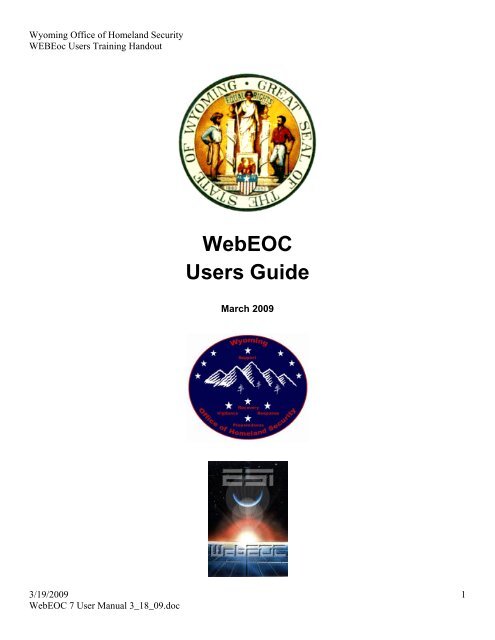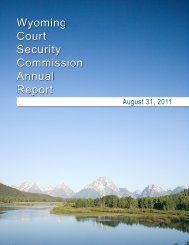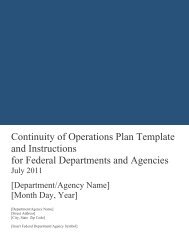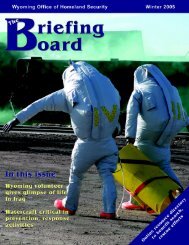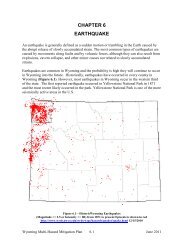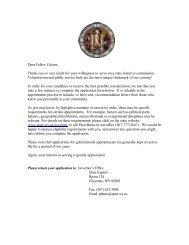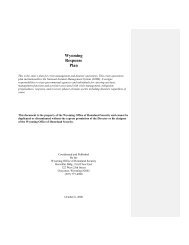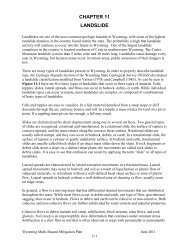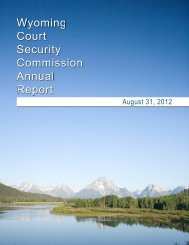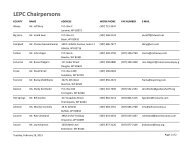WebEOC Users Guide - Wyoming Homeland Security
WebEOC Users Guide - Wyoming Homeland Security
WebEOC Users Guide - Wyoming Homeland Security
- No tags were found...
Create successful ePaper yourself
Turn your PDF publications into a flip-book with our unique Google optimized e-Paper software.
<strong>Wyoming</strong> Office of <strong>Homeland</strong> <strong>Security</strong>WEBEoc <strong>Users</strong> Training Handout<strong>WebEOC</strong><strong>Users</strong> <strong>Guide</strong>March 20093/19/2009<strong>WebEOC</strong> 7 User Manual 3_18_09.doc1
<strong>Wyoming</strong> Office of <strong>Homeland</strong> <strong>Security</strong>WEBEoc <strong>Users</strong> Training HandoutTable of ContentsWebEoc Point of Contact ………………………………………………… 2WebEoc Overview ………………………………………………………… 3WebEoc Log On …………………………………………………………… 3Multiple Log On …………………………………………………………… 6Control Panel ………………………………………………………………. 7Status Boards ……………………………………………………………… 9Chat Sessions ……………………………………………………………… 13Contact Lists ........................................................................................ 16Checklists ………………………………………………………..………… 18MapTec ……………………………………………………………..………. 20<strong>WebEOC</strong> Points of Contact<strong>WebEOC</strong> is administered by the <strong>Wyoming</strong> Office of <strong>Homeland</strong> <strong>Security</strong>. For technical assistance,please contact:Primary Contact Alternative Contact Second Alternative Contact:Stewart BybeeSBybee@state.wy.us307.777.4906 (Office)307.631.5510 (Cell)Larry GreenLgreen1@state.wy.us307.777.4908 (Office)307.214.9716 (Cell)<strong>Wyoming</strong> Office of<strong>Homeland</strong> <strong>Security</strong>307.777.4900 (Main office)(24/7 Number)3/19/2009<strong>WebEOC</strong> 7 User Manual 3_18_09.doc2
<strong>Wyoming</strong> Office of <strong>Homeland</strong> <strong>Security</strong>WEBEoc <strong>Users</strong> Training HandoutWhat is <strong>WebEOC</strong>?<strong>WebEOC</strong> is software designed to bring real-time emergency information management to incidentsand events that spread across geographical areas and or across multiple agencies. <strong>WebEOC</strong> is aweb-based technology from Emergency Services Integrators (ESi) developed for the federalgovernment and has been redefined for multiple uses. This results in secure, real-time access tostate and national weather trends, satellite images, mapping information, details of operations in otherjurisdictions, local, regional and even national resource status and other data vital to the efficientmanagement of any contingency (even if the jurisdiction hasn't invested in any of the sources of thesedata).<strong>WebEOC</strong> allows “real-time” information postings and communication over a secure internetconnection. This information includes text status reports, chat rooms, visual displays for maps andphotos, resource tracking, and task checklists.PrerequisitesTo use <strong>WebEOC</strong>, you will need to have a few prerequisites:• A personal computer with internet access.• A username. This user name must be assigned to you by a <strong>WebEOC</strong> administrator from the<strong>Wyoming</strong> Office of <strong>Homeland</strong> <strong>Security</strong> (WOHS). The username defines who you are as youutilize <strong>WebEOC</strong> and allows you access.• A password. Your initial password will be assigned to you by a WOHS <strong>WebEOC</strong>administrator. The first time you log onto the system, you will be prompted to select a newpassword. Select a password that will be easy for you to remember and do not give yourpassword out to other individuals or groups. The password allows the user to access<strong>WebEOC</strong>.Logging in to <strong>WebEOC</strong><strong>WebEOC</strong> is accessed through Microsoft ® Internet Explorer TM 6.0 or higher.To log in to <strong>WebEOC</strong>, perform the following:Start your web browser (e.g., Internet Explorer). Access the <strong>WebEOC</strong> hotlink found at:http://wyohomelandsecurity.state.wy.us/The <strong>WebEOC</strong> Login window displays, as shown below.A Jurisdiction list will appear at the top of the <strong>WebEOC</strong> Login window. Your jurisdiction should bea county, department, agency or functional entity as determined by the <strong>Wyoming</strong> office of<strong>Homeland</strong> <strong>Security</strong> (WOHS). Select your Jurisdiction (listed in alphabetical order) from the3/19/2009<strong>WebEOC</strong> 7 User Manual 3_18_09.doc3
<strong>Wyoming</strong> Office of <strong>Homeland</strong> <strong>Security</strong>WEBEoc <strong>Users</strong> Training Handoutdrop-down list or maintain the All Jurisdictions default, as shown below.When a jurisdiction is selected, the User and Incident drop-down lists will be filtered to list onlythose assigned to the jurisdiction. Selecting a jurisdiction also sets the time zone for the user loggingin to <strong>WebEOC</strong>.Note: If your user name does not appear in the User selection list when All Jurisdictions isselected, contact your <strong>WebEOC</strong> Administrator.From the User selection list (listed in alphabetical order), highlight your user name, as shown.3/19/2009<strong>WebEOC</strong> 7 User Manual 3_18_09.doc4
<strong>Wyoming</strong> Office of <strong>Homeland</strong> <strong>Security</strong>WEBEoc <strong>Users</strong> Training HandoutIn the Password field, enter your password, as shown below. Note: The password is casesensitive. Passwords may be any amount of characters, no restrictions.As you enter your password, values display as a series of asterisks (******). If you have forgottenyour password, contact a <strong>WebEOC</strong> Administrator.3/19/2009<strong>WebEOC</strong> 7 User Manual 3_18_09.doc5
<strong>Wyoming</strong> Office of <strong>Homeland</strong> <strong>Security</strong>WEBEoc <strong>Users</strong> Training Handout6. From the Incident drop-down list, select an incident.The line containing the selected incident is highlighted. All users must select the same INCIDENT,in order for message postings to be recorded and displayed on the appropriate message board.Multiple Log-InsLog-in accounts can be configured as either single or multi-user. Multi-User accounts allow more thanone user to log in as the same user at any one time. Single User accounts allow only one person tobe logged in as a particular username (i.e., account). <strong>Users</strong> cannot log in to an active "single-user"account without logging out the other user, as shown.If you click OK, the other user is involuntarily logged off and receives a pop-up advisory in theirControl Panel, as shown. Once involuntarily logged off by an administrator or another user, thelogged off user should exit the system (by clicking Log Out) and attempt to log back in. If thedialog illustrated in the previous step is experienced when attempting to log back in, click Canceland contact the <strong>WebEOC</strong> Administrator for assistance in troubleshooting the problem.When you have successfully logged in to <strong>WebEOC</strong>, the Control Panel appears, as shown below.The Control Panel that displays when you login will contain only those boards, menus, links and pluginsassigned to your group by a <strong>WebEOC</strong> Administrator. If you have not been assigned to a Group,your Control Panel will be blank.3/19/2009<strong>WebEOC</strong> 7 User Manual 3_18_09.doc6
<strong>Wyoming</strong> Office of <strong>Homeland</strong> <strong>Security</strong>WEBEoc <strong>Users</strong> Training HandoutControl PanelThe Control Panel is divided into two functional areas.• The top portion of the Control Panel provides access to the Admin Manager, the Log Offbutton.• The lower portion of the Control Panel contains the status boards, menus, plug-ins, and links.3/19/2009<strong>WebEOC</strong> 7 User Manual 3_18_09.doc7
<strong>Wyoming</strong> Office of <strong>Homeland</strong> <strong>Security</strong>WEBEoc <strong>Users</strong> Training HandoutPermissions have been assigned by an WOHS administrator.The Control Panel (or any <strong>WebEOC</strong> window) may be resized using standard Windows functions andmoved to any position on the desktop.To open a display, either select the adjacent checkbox or click on the link (i.e, the name) on theControl Panel.• Chat, Checklists, Contacts, and Messages may be opened by clicking the correspondinglink.• Within the Control Panel are: status boards, menus, plug-ins, and links and can be opened byeither selecting the adjacent checkbox or by clicking on the link (i.e., the name). Only thoseitems to which a user has been granted access will appear on the Control Panel.• The Add/Update button adjacent to a status board opens the Board Ops window. It containsthe necessary tools to manage and post information to a board.• The Log Off button allows the user to exit <strong>WebEOC</strong>.3/19/2009<strong>WebEOC</strong> 7 User Manual 3_18_09.doc8
<strong>Wyoming</strong> Office of <strong>Homeland</strong> <strong>Security</strong>WEBEoc <strong>Users</strong> Training HandoutAbout Status BoardsStatus Boards are the heart of <strong>WebEOC</strong>. They provide the mechanism to share real-timeinformation with authorized users everywhere.In <strong>WebEOC</strong>, incident information is transmitted and displayed in status boards making the informationuniversally available to all authorized users simultaneously.Within the context of <strong>WebEOC</strong>, a status board is an electronic version of large, chronological orcategorical paper-based status boards.Open a BoardTo open a message board, menu, plug-in, or link, simply click on the words, this is a “hot link”. Thisopens the display view. To input a message to a board, simply click on the + (plus sign) to the rightof the message board.3/19/2009<strong>WebEOC</strong> 7 User Manual 3_18_09.doc9
<strong>Wyoming</strong> Office of <strong>Homeland</strong> <strong>Security</strong>WEBEoc <strong>Users</strong> Training HandoutClose a Board<strong>Users</strong> may close a status board, menu, plug-in, or link, by clicking the RED "X" in the upper right cornerof the.Multiple status boards and/or multiple copies of a status board, menu window, plug-in or link may bedisplayed simultaneously. This feature allows you to display these windows on one or more monitorsor projected displays.Once a display has been opened, additional copies can be displayed by clicking the link once foreach additional copy. These displays can then be positioned as desired.Status boards appear, on the control panel, alphabetically in their respective groups, and can beopened by clicking on the link (i.e., the name). Only those items to which a user has been grantedaccess will appear on the Control Panel.Indicator LightsIndicator Lights, The Messages will be RED if there is a message which has not been read, otherwiseit is black text.3/19/2009<strong>WebEOC</strong> 7 User Manual 3_18_09.doc10
<strong>Wyoming</strong> Office of <strong>Homeland</strong> <strong>Security</strong>WEBEoc <strong>Users</strong> Training HandoutUpdating/Adding Reports to the Status BoardsSituation reports should be added to the status boards during any event when the need arises.To update/add reports perform the following: To input a message to a board, simply click on the +(plus sign) to the right of the message board.3/19/2009<strong>WebEOC</strong> 7 User Manual 3_18_09.doc11
<strong>Wyoming</strong> Office of <strong>Homeland</strong> <strong>Security</strong>WEBEoc <strong>Users</strong> Training Handout1. An Input dialog box window will pop up, as shown below.2. Select an Event Type from the drop down menu.3. Typel the location from which you are reporting.4. Provide a brief description of activities or a situation report of the current situation. UseONLY plain speech. Do not use acronyms, abbreviations, codes (like 10-Codes), or nicknames.5. Click the save button at the top of the New Record window. You record is now saved andposted to the Status Board.Please note that the New Record window may appear slightly differently for individual usersdependant upon the rights the user has been granted. The different appearances will not, in any wayimpact the ability of users to post information to <strong>WebEOC</strong>.3/19/200912<strong>WebEOC</strong> 7 User Manual 3_18_09.doc
<strong>Wyoming</strong> Office of <strong>Homeland</strong> <strong>Security</strong>WEBEoc <strong>Users</strong> Training HandoutAbout ChatThe Chat Plug-In allows <strong>WebEOC</strong> users to create chat rooms and conduct online text conversationsin real-time. User permissions can be granted to edit chat rooms (create and delete) or limited to justparticipating (send text messages) in existing chat rooms. A chat room can be password-protected bythe chat room creator or <strong>WebEOC</strong> Administrator.3/19/2009<strong>WebEOC</strong> 7 User Manual 3_18_09.doc13
<strong>Wyoming</strong> Office of <strong>Homeland</strong> <strong>Security</strong>WEBEoc <strong>Users</strong> Training HandoutCreating a Chat RoomTo access Chat, click the Chat link on the Control Panel. The Chat window will display. To adda Chat Room: a) Click the Add Chat Room button. (See above graphic) b) below is the dialogbox which will appear.3/19/2009<strong>WebEOC</strong> 7 User Manual 3_18_09.doc14
<strong>Wyoming</strong> Office of <strong>Homeland</strong> <strong>Security</strong>WEBEoc <strong>Users</strong> Training HandoutUsing Chat1. To use a chat room, perform the following steps:2. Click the Chat link on the Control Panel.3. Click the name of the chat room to enter.4. Type the message in the bottom Text Message area. Click Send. The message will beadded to the Messages Pane.5. Note: You will see all messages posted by participants unless you exit the chat room andthen subsequently re-enter.6. To leave the chat room, click Leave Room.3/19/2009<strong>WebEOC</strong> 7 User Manual 3_18_09.doc15
<strong>Wyoming</strong> Office of <strong>Homeland</strong> <strong>Security</strong>WEBEoc <strong>Users</strong> Training HandoutAbout ContactsThe Contacts Plug-In provides the ability to maintain a notification directory of detailed contact informationthat can be tailored and updated as required. Information recorded for each contact includesagency (or person) name, telephone, mobile and pager numbers, physical and email addresses, andspecial notes or comments for the contact.Sorting Contacts1. Click the Contacts link on the Control Panel.The Contacts window will display.2. To sort Contacts, click on the column heading corresponding to the sort you wish toexecute: Name, Agency, Phone, Pager, or Mobile.The list will sort and display in ascending order.Note: The default sort is by Name in ascending order.Viewing Contact InformationTo display detailed information for a contact, perform the following steps:1. Click the Contacts link on the Control Panel. The Contacts window will display.2. Click the name of the contact to display.The Edit Contact window will display, complete with the details available for that contact, as shown.3/19/2009<strong>WebEOC</strong> 7 User Manual 3_18_09.doc16
<strong>Wyoming</strong> Office of <strong>Homeland</strong> <strong>Security</strong>WEBEoc <strong>Users</strong> Training Handout3. Click Cancel or Back to exit the Edit Contact detail window and return to the Contacts window.3/19/2009<strong>WebEOC</strong> 7 User Manual 3_18_09.doc17
<strong>Wyoming</strong> Office of <strong>Homeland</strong> <strong>Security</strong>WEBEoc <strong>Users</strong> Training HandoutAbout Checklists<strong>WebEOC</strong> provides the capability for an organization to automate procedures and checklists with thelook and feel of a word processing file. Steps are identified as a main numbered step, or aletter/number sub-step that can be statused as Open, Complete, Previously Accomplished, or NotApplicable. If this functionality is not desired, steps can simply be marked as Completed.To pull up a checklist, click the “Checklist button on the Control Panel, when prompted select thechecklist that applies to your needs. The appropriate checklist will be brought up for your use.<strong>Users</strong> can add remarks to any step with the option of viewing or hiding the remarks. Checklists areincident specific. This means a checklist (e.g., Bomb Threat) used in one incident can also be usedsimultaneously and independently in a second incident, but information associated with each incidentis stored with the associated incident when archived.Administrators have the added capability to assign a due time for a step. When the due time isexceeded, the status indicator field for the step or sub-step turns red.3/19/2009<strong>WebEOC</strong> 7 User Manual 3_18_09.doc18
<strong>Wyoming</strong> Office of <strong>Homeland</strong> <strong>Security</strong>WEBEoc <strong>Users</strong> Training HandoutThe Checklists window defaults to the first checklist in the drop-down list. A different checklist maybe viewed by selecting it from the drop-down list.To close the Checklists, click the "X" located in the top right corner of the Checklists window.Overview of Statuses for a StepOverview of Statuses for a StepA step can be set to one of the following statuses located in the Checklist key legend (as shown inFigure 7-1):• C: Complete• O: Open/In-Progress• P: Previously Accomplished• N: Not Applicable• Blank: Not started.Changing the Status of a StepTo set the status for a step, select a value from the drop-down list adjacent to the step.Steps may have a due time associated with them. The time is based on the Incident date/time. If astep is Blank or O(open/In-Progress) and the time for completion (due time) has been exceeded, thebackground color of the status field will display in red.3/19/2009<strong>WebEOC</strong> 7 User Manual 3_18_09.doc19
<strong>Wyoming</strong> Office of <strong>Homeland</strong> <strong>Security</strong>WEBEoc <strong>Users</strong> Training HandoutAbout MapTacMapTac 1 was created to replace or augment static, paper-based maps and magnetic light boardscommon in many EOCs. MapTac is a unique tool in <strong>WebEOC</strong> that allows an authorized user to"publish" a map, dispersion model, digital photo, etc., from any map/GIS source or digital camera andusing their web browser, share the "tactical scene" with authorized users instantly.MapTac can be used with any GIS or mapping system that can produce a static picture file (.jpg, .gif,.bmp). Existing web-based mapping resources available on the Internet, such as Yahoo Maps,Delorme, etc., can also be used to plot virtually any address. These can then be saved to MapTacand annotated as necessary. MapTac also allows responders at geographically separate locations toview, and depending on user privileges, update resources real-time.<strong>Users</strong> with the appropriate permissions can add markers such as push pins, fire trucks, road blocks,etc., with or without labels. Labels can be added any time and edited. URLs can be added to iconsthat allow users access to related information.Viewing and Printing a MapTo access a map for viewing, perform the following steps:1. To access MapTac, click the MapTac plug-in on the Control Panel.2. Select a map for display from the Maps drop-down list. The image displays in the MapView Area.3. To print a map, click the Print (printer) icon in the lower right hand corner of the map.4. MapTac (Plug-in Option)3/19/2009<strong>WebEOC</strong> 7 User Manual 3_18_09.doc20
<strong>Wyoming</strong> Office of <strong>Homeland</strong> <strong>Security</strong>WEBEoc <strong>Users</strong> Training HandoutPlacing Markers on a MapTo place a marker on a map, perform the following steps:Click the desired Marker tab (e.g., General) to display the Marker Palette. Note: Icons may begrouped and available under different marker tabs, as shown in Figure 14-4.1. In the Marker Palette, click on the desired marker (e.g., radiological marker) to be placed inthe Map View Area, as shown in Figure 14-5.2. Position the cursor at the location on the map where the marker is to be placed and singleclickthe mouse. The marker is stationed at the position specified.Moving MarkersTo move a marker, perform the following steps:1. Click and hold the left mouse button on the marker you wish to move.3/19/2009<strong>WebEOC</strong> 7 User Manual 3_18_09.doc21
<strong>Wyoming</strong> Office of <strong>Homeland</strong> <strong>Security</strong>WEBEoc <strong>Users</strong> Training Handout2. Drag the marker to the new location and release the mouse button.Deleting a MarkerTo delete a marker, perform the following steps:1. To delete a marker, right click on the marker. A delete confirmation dialog will display,.2. Click OK to delete the marker. OR Click Cancel to return to the map without deleting themarker.Placing a Shape on a MapTo place a shape on a map, perform the following steps:Click the Shapes tab to display the Shape Palette, as shown in Figure 14-8.Click on the desired Shape button (ellipse, polygon, or line) from the Shape Palette.Select the shape color from the Shapes Color selection list.To draw an ellipse: a) Click on the Ellipse drawing tool. b) Click on the map at the center point for theellipse. Then move the mouse to draw. c) Click the left mouse button when finished drawing, asshown in Figure 14-9.To draw a polygon: a) Click on the Polygon drawing tool. b) Click on the map at each of thecorners for the polygon then return to the first corner. c) Click to complete the shape.To draw a line: a) Click on the Line Shape drawing tool. b) Click on the map to start the line. c) Drawthe line with the mouse. Click again to finish the line.To collapse (i.e., hide) the Shapes Palette, click on the Shapes tab.Deleting a ShapeTo delete a shape, perform the following steps:1. Right click on the shape. A delete confirmation dialog will display.2. Click OK to delete the shape. OR Click Cancel to return to the map without deleting theshape.3/19/2009<strong>WebEOC</strong> 7 User Manual 3_18_09.doc22
<strong>Wyoming</strong> Office of <strong>Homeland</strong> <strong>Security</strong>WEBEoc <strong>Users</strong> Training HandoutAdding a Label to a MarkerLabels can be added to a marker from the Marker Palette. Note: Labels cannot be added to Shapes.To add a label to a marker, perform the following steps:1. Click the Labels tab to display the Label Palette, as shown in Figure 14-14.2. Click the Set Label button to select the set label function, as shown in Figure 14-15.3. Click on the marker to be labeled.4. Enter the text for the label and click OK.Clearing a Label on a MarkerTo clear a label on a marker, perform the following steps:1. Click the Labels tab to display the Label Palette, as shown in Figure 14-18.2. Click the Clear Label button to select the Clear Label3/19/2009<strong>WebEOC</strong> 7 User Manual 3_18_09.doc23


